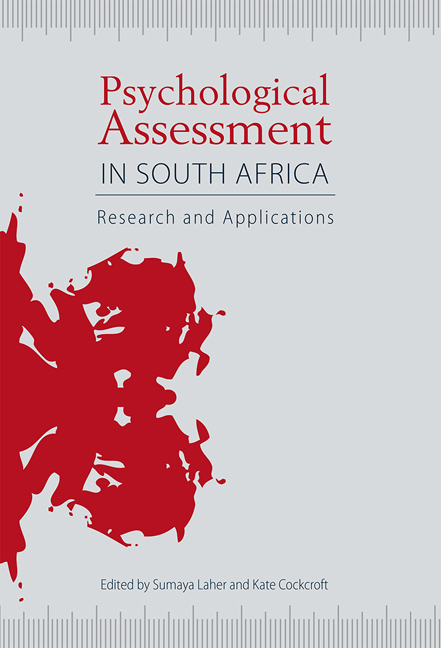Book contents
- Frontmatter
- Contents
- Tables and figures
- Acknowledgements
- Acronyms and abbreviations
- 1 Contextualising psychological assessment in South Africa
- Section One Cognitive tests: conceptual and practical applications
- Section Two Personality and projective tests: conceptual and practical applications
- 14 The Sixteen Personality Factor Questionnaire in South Africa
- 15 Using the Fifteen Factor Questionnaire Plus in South Africa
- 16 The Basic Traits Inventory
- 17 The Myers-Briggs Type Indicator® in South Africa
- 18 The NEO-PI-R in South Africa
- 19 Using the Occupational Personality Profile in South Africa
- 20 The Occupational Personality Questionnaire
- 21 The Millon Inventories in South Africa
- 22 Assessment and monitoring of symptoms in the treatment of psychological problems
- 23 Assessment in routine clinical and counselling settings
- 24 Projective assessment of adults and children in South Africa
- 25 The use of the Children's Apperception Test and Thematic Apperception Test in South Africa
- 26 Projective assessment using the Draw-A-Person Test and Kinetic Family Drawing in South Africa
- 27 The Rorschach in South Africa
- Section Three Assessment approaches and methodologies
- Contributors
- Index
25 - The use of the Children's Apperception Test and Thematic Apperception Test in South Africa
from Section Two - Personality and projective tests: conceptual and practical applications
Published online by Cambridge University Press: 21 April 2018
- Frontmatter
- Contents
- Tables and figures
- Acknowledgements
- Acronyms and abbreviations
- 1 Contextualising psychological assessment in South Africa
- Section One Cognitive tests: conceptual and practical applications
- Section Two Personality and projective tests: conceptual and practical applications
- 14 The Sixteen Personality Factor Questionnaire in South Africa
- 15 Using the Fifteen Factor Questionnaire Plus in South Africa
- 16 The Basic Traits Inventory
- 17 The Myers-Briggs Type Indicator® in South Africa
- 18 The NEO-PI-R in South Africa
- 19 Using the Occupational Personality Profile in South Africa
- 20 The Occupational Personality Questionnaire
- 21 The Millon Inventories in South Africa
- 22 Assessment and monitoring of symptoms in the treatment of psychological problems
- 23 Assessment in routine clinical and counselling settings
- 24 Projective assessment of adults and children in South Africa
- 25 The use of the Children's Apperception Test and Thematic Apperception Test in South Africa
- 26 Projective assessment using the Draw-A-Person Test and Kinetic Family Drawing in South Africa
- 27 The Rorschach in South Africa
- Section Three Assessment approaches and methodologies
- Contributors
- Index
Summary
This chapter explores the practice and cross-cultural application of two thematic projective techniques, the Children's Apperception Test (CAT) and the Thematic Apperception Test (TAT). A brief introduction to, and definition of, thematic storytelling techniques is followed by discussions on reliability and validity, test administration and clinical application. The chapter has a strong focus on clinical application within a South African context and provides guidelines for clinicians. The focus on case material also allows the utility of these tests to be illustrated in depth.
The development of apperception testing
The origin of projective testing was Herman Rorschach's (1924a; 1924b) accidental discovery that people automatically and unconsciously project their own hidden desires, fears, wishes, feelings, conflicts and attitudes onto unstructured stimuli. As with individual interpretations given to a work of art, so we canvas our experiences, perceptions and reflections from an internal palette. He termed this process ‘apperception’ (Rorschach, 1924b, p.359). The concept ‘projection’, however, developed from Freud's (1938) theory of the unconscious and of the consequent use of projection as a defence. Freud conceived of the unconscious as a repository of instincts, wishes and fantasies deemed unacceptable to consciousness, thereby becoming the object of repression, hidden from conscious awareness. These unacceptable feelings and impulses are projected outside the self so that, for example, a group of people are experienced in a certain way that is more telling of the subject than of the other. To quote Freud, ‘experience shows that we understand very well how to interpret in other people … the same acts which we refuse to acknowledge as being mental in ourselves’ (1955, p.171). Projective assessments are therefore administered to describe a person's subjective experience of him- or herself, and relationships with others and the world, often in response to queries about the psychological underpinnings of reported emotional and/or behavioural problems, or to assist with diagnosing emotional disturbances.
Morgan and Murray (1935) also referred to the process as ‘apperception’ and described a technique for investigating fantasies in their introduction to the TAT. Subsequent to this initial introduction, the TAT has seen numerous revisions, inclusion of scoring systems and development of an apperception test specifically tailored for use with children (Bellak, 1944; 1954; 1971; 1975; 1986; 1993; Bellak & Abrams, 1997; Bellak & Bellak, 1949; 1965).
- Type
- Chapter
- Information
- Psychological Assessment in South AfricaResearch and Applications, pp. 355 - 374Publisher: Wits University PressPrint publication year: 2013



